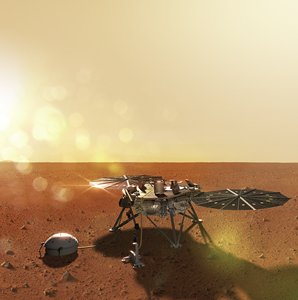Aerojet Rocketdyne Propulsion Delivers Mars InSight to Planet’s Surface
-
Aerojet Rocketdyne powered all phases of NASA’s Mars InSight journey
- Sophisticated Aerojet Rocketdyne propulsion maneuvered the spacecraft to the Martian surface
- Aerojet Rocketdyne has enabled every successful landing on Mars
REDMOND, Wash., Nov. 26, 2018 (GLOBE NEWSWIRE) -- Using sophisticated propulsion devices provided by Aerojet Rocketdyne, NASA’s Mars InSight lander successfully touched down on the surface of the red planet Nov. 26.
|
|||||
The final phase of lnSight’s descent was powered by 12 Aerojet Rocketdyne MR-107N 50 lbf engines, providing variable pounds of pulsed thrust throughout its descent, which began firing after the lander jettisoned its parachute and heat shield. The engines maneuvered the craft clear of the falling parachute before bringing it gently to the Martian surface, where it will gather data on the planet’s seismology, rotation and internal temperature.
“We provided propulsion for every phase of this important NASA mission, from launch to landing,” said Eileen Drake, Aerojet Rocketdyne CEO and president. “A mission like this leaves no margin for error and our systems successfully performed their critical roles as expected.”
Mars InSight began its journey May 5 with its launch from Vandenberg Air Force Base, California, aboard a United Launch Alliance Atlas V rocket. Aerojet Rocketdyne supplied the RL10C-1 main engine and 12 MR-106 reaction control thrusters for the rocket’s Centaur upper stage, as well as helium pressurization tanks for the vehicle’s first and second stages.
During InSight’s roughly six-month cruise to Mars, four Aerojet Rocketdyne MR-106B thrusters, each generating four pounds of thrust, kept the probe on target via five trajectory correction maneuvers. Meanwhile, four MR-111C thrusters, each generating one pound of thrust, kept the craft stable and pointed in the right direction.
These same thrusters provided the final trajectory and pointing adjustments as the lander approached the Martian atmosphere. Aerojet Rocketdyne also supplied two helium pressurization tanks on the lander.
Mars InSight will study the deep interior of Mars, examining in depth its crust, mantle, and core. Aerojet Rocketdyne engines have flown aboard every successful U.S. Mars mission, including orbiters and landers. Additionally, Aerojet Rocketdyne propulsion systems have taken NASA probes to every planet in the solar system and even beyond. The agency’s two Voyager probes, which launched in 1977, are equipped with Aerojet Rocketdyne thrusters. Voyager 1 is in interstellar space, while Voyager 2 is in the heliosheath, the outermost layer of the heliosphere.
Watch the latest episode of our social media show, Fuel for Thought, for additional details on Aerojet Rocketdyne’s role in NASA’s InSight mission: Fuel for Thought – S1 E3 Mars InSight.
About Aerojet Rocketdyne: Aerojet Rocketdyne, a subsidiary of Aerojet Rocketdyne Holdings, Inc. (NYSE:AJRD), is a world-recognized aerospace and defense leader that provides propulsion systems and energetics to the space, missile defense and strategic systems, and tactical systems areas, in support of domestic and international customers. For more information, visit www.Rocket.com and www.AerojetRocketdyne.com. Follow Aerojet Rocketdyne and CEO Eileen Drake on Twitter at @AerojetRdyne and @DrakeEileen.
Media Contacts:
Ashley Gudzak, Aerojet Rocketdyne, 571-236-4091
Ashley.Gudzak@Rocket.com
Mary Engola, Aerojet Rocketdyne, 571-289-1371
Mary.Engola@Rocket.com
A photo accompanying this announcement is available at http://www.globenewswire.com/NewsRoom/AttachmentNg/3a231c84-3490-4eab-99ed-b68ce2d95f4a
Legal Disclaimer:
EIN Presswire provides this news content "as is" without warranty of any kind. We do not accept any responsibility or liability for the accuracy, content, images, videos, licenses, completeness, legality, or reliability of the information contained in this article. If you have any complaints or copyright issues related to this article, kindly contact the author above.


